An Evolution in Light
by Neil Murphy
Haiku, HI
Click on any picture to see a larger version.
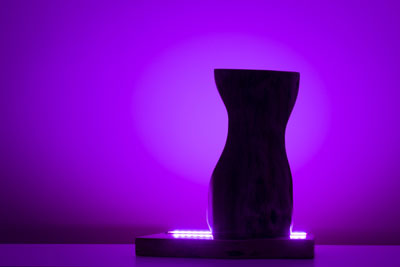
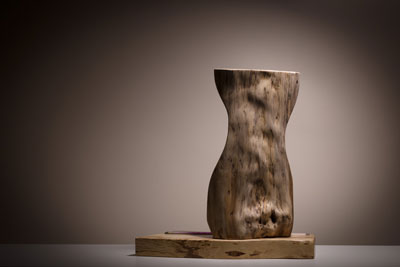
|
Sigh - A Yew wood form on Irish Oak base with Purple light (On and Off)
|
Woodworking has been my passion for over 30 years, and I'm happiest when deep in some interesting project. Ever since my father, a master carpenter, would leave tools lying around our unfinished house, I've been working on wood. Not always to his pleasure, as there are still some of my saw-induced scars on the house. What he taught me though, allowed me to spend almost 20 years in the USA, honing my skills on a variety of custom-built homes, enjoying some intriguing projects along the way. For the past 10 years I've been carrying on with original works in Ireland, the UK and even a fit-out of an Irish pub exported to Bulgaria.
There comes a point, however, when you need to use these skills for yourself, rather than always building someone else's dream. And lighting has always intrigued me. So, the idea germinated. How to combine wood and light to create something that could be seen as both beautiful and functional, and not just utilitarian?
The year was 2011, in deepest West Cork, and I was working on the remodeling of a section of The Four Alls pub, which has been in my friends family for seven generations. Deep into the project, when all the wood had been fitted and placed, and the finishing touches were being added, I had a Eureka moment. The locally-sourced, sustainably-managed and harvested hardwoods we were using in their natural shapes, curves and bark-crusted edges to recreate the wonder-filled, communal Irish pub days of old, had presented me with a major conundrum.
As my friend brought the past back to life with the flowing grains of these incredible woods, all I could hear was the sound of light pinging about in my mind.
How to make beautiful hardwoods shine?
If I could get to the root of this problem, literally, there was potential to design and create lights. I'd almost gone back in time in this pub, though, finding that slapping square and flat woods on walls or floors wasn't as interesting, or as provocative, as working with raw woods, straight from the sawmills. Curves, bows, deflections, spalting, splits, pockets – all made the wood so much more interesting, gave it so much more texture - perfect not just for lighting effects, but also as focal-point furniture. There’s always a place for beautiful woods and grains, among the plastics, steels, ceramics, and irons that populate the artistic world. Doesn’t beautiful hardwood provide its own take on form and function?
At the heart of my conundrum was the notion of somehow combining my woodworking and lighting, not separately as I had been trying to do, since I had qualified as a light designer from South Bank University in London in 2004, but somehow creating the fusion of light and wood. Both media demand more than a modicum of artistic endeavor – and it was important to be faithful to that ideal. It's a high standard – impressing through an expression of contemporary fusion - but impressing also the stylish Catalana chica that was now by my side, infused as she was with the style and legacy she brings from her city.
In August of 2012, we took an expedition to Barcelona, the home of my wife Ariadna Vallcorba Belsa. Barcelona is a city that has an amazing capacity to rapidly activate the senses. I went there having created a handful of experimental floor lights – prototypes, the initial realization of my lighting concepts. Ideas, inspirations, and igniters ebbed and flowed. Lights flickered. But the Design Trail through Barcelona showed us no lights of hardwood. I was pleased, however, to illuminate our freewheeling with a steady diffusion of white light, in all manner of stylish materials, shapes and sizes.
One stunning light store with the eye of a gallery, hosted an array of exquisite chandeliers arranged under flowing walkways so you could feel the vigor of each, enhanced by stunning lights laid out sparingly on the sides. A small pressed wood desk light shone here, a wood floor lamp there but nothing that we could see that crossed the spectrum of lights we had created to date, or had in mind. It seemed that in a city of this magnitude of design and arts, our mood lights concept was bound to be original. The climate has a lot to do with a lack of beautiful hardwoods in the Med.
A direction suddenly became clear – maybe, just maybe we had discovered a new design trail. Barcelona had shown it was possible to make light, in style. But how do you improve something that has been evolving since the advent of fire, the original mood light? There was no point in competing with conventional lamps, but mood lighting was a different prospect. This seemed a better fit for fusing contemporary lighting with ancient hardwoods.
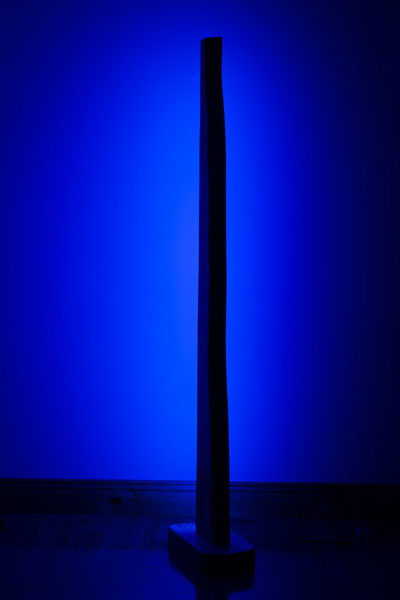
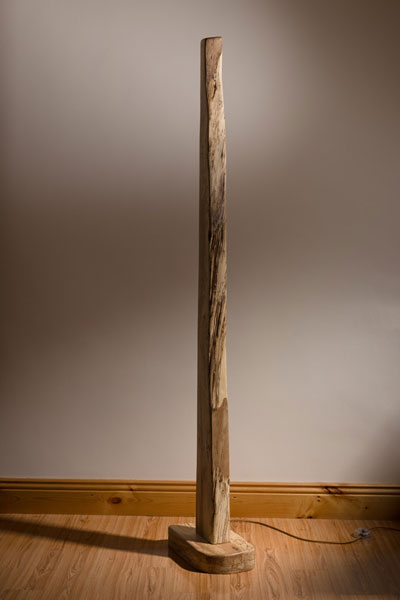
|
Merry Blue - Spalted Beech base and tower, 6 feet tall with Blue light (On and Off)
|
Such hardwoods are in plentiful supply in Cork, sustainably harvested and kiln-dried, from country estates all over the land – from the fabled Blarney Castle Estate to the country estate that once forged cannons for the American Civil War. Planted by British estate owners in the late 1700s and early 1800s, and thousands of acres full. The beauty of these hardwoods dictated that the
devil was in the detail
- a critical factor. So all lighting and components had to be sourced from reputable companies that provided good warranties. Steadily, over the next 18 months, the product developed.
Amid all the attention to detail, lay a dilemma, as each light had to have an element of mystery to it, a bit of magic – so that it's not quite apparent how it works, or why. The solution lay within the wood, and when discovered, was the moment our lights developed mood. The mystery allowed us to combine the 'form' of wood and the 'function' of mood light, adding colorful decorative cable, with a stylish switch and plug.
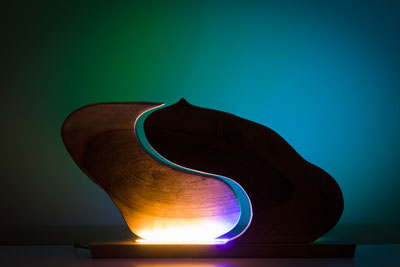
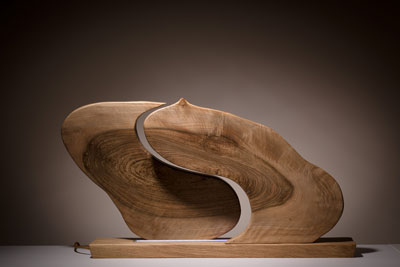
|
YinYang - Irish Walnut form on Brown Ash base, 6 feet tall with Turquoise light (On and Off)
|
Now we had our product – a mood light of beautiful wood, fused with contemporary light, in colors chosen to reflect the mood required. We had been playing with the psychology of color as our lights developed, and each one serves a unique purpose - orange light for relaxing, red to stir passion, green for grounding.
But our breakthrough only led to a much bigger problem – marketing, exhibiting and sales.
We took a stand at an art fair in The Chelsea Old Town Hall, on the Kings Road in London in February 2014 to test the waters. And it was quite the fashionable experience too – being at the heart of London's exclusive shopping district. But we managed to sell one of our light sculptures to a collector with a 10-acre sculpture park south of the city, and got six more lights into a design store in stylish East London. This meant, of course, that now we could sell too. But marketing is still our biggest ongoing challenge.
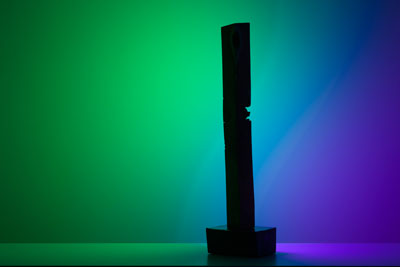
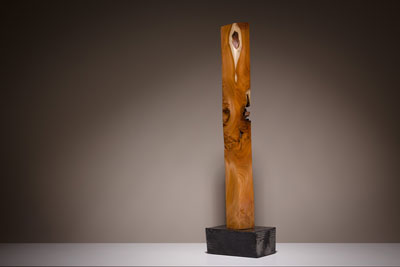
|
Yew Tide - Yew Stem on a molded black plastic base, with Purple and Green lights (On and Off)
|
St. Peters Church was the venue we chose for our first major exhibition, for the months of January and February 2015, for maximum effect during the darkest, greyest days of a North Atlantic winter. Add in the annual post-Christmas hangover, and we had finally found the perfect venue for our lights. My father had been the contractor entrusted with the renovation of this dilapidated church twenty years previously and 'The Evolution of Light' exhibition was the perfect launch pad. We had twenty-nine lights, of various shapes and sizes, on display, which created a vibrancy never seen before in that old church.
We've since moved to Maui in Hawaii – where the hardwoods are as beautiful as Irish hardwoods, and so we continue our work, with mango. monkey-pod and koa woods.
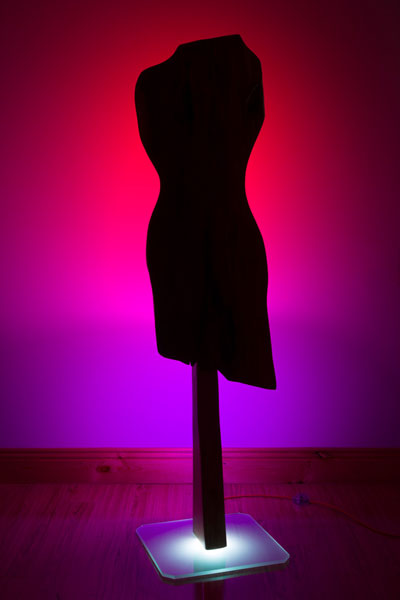
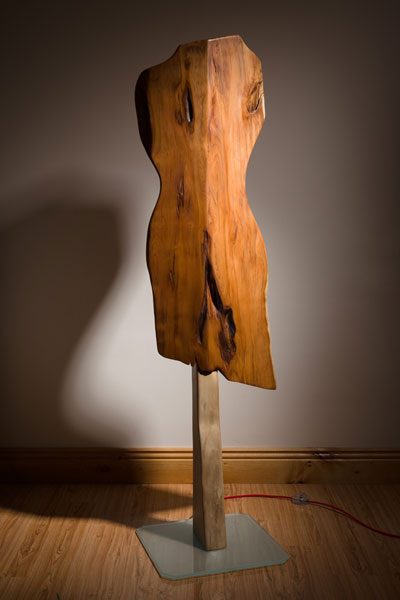
|
Yew & Eye - Yew wood body on a Sycamore leg with frosted glass base, 6 feet tall,
with Red, Pink, and White lights (On and Off)
|
Making lights is not just how we make a living, this is the way we live our life – always with the form and the function. This is the essence of our philosophy - to live and work in places of beauty, doing the things that we love. And always experiencing life in color, and seeing new colors, which compels us to attempt to replicate that in our lights.
In the words of Carlo Mollino –
"Everything is permissible as long as it is fantastic."
You can email Neil at
lushelight@gmail.com
. You can also visit his website at
http://www.lushelight.com/
Return to
Wood News
front page


